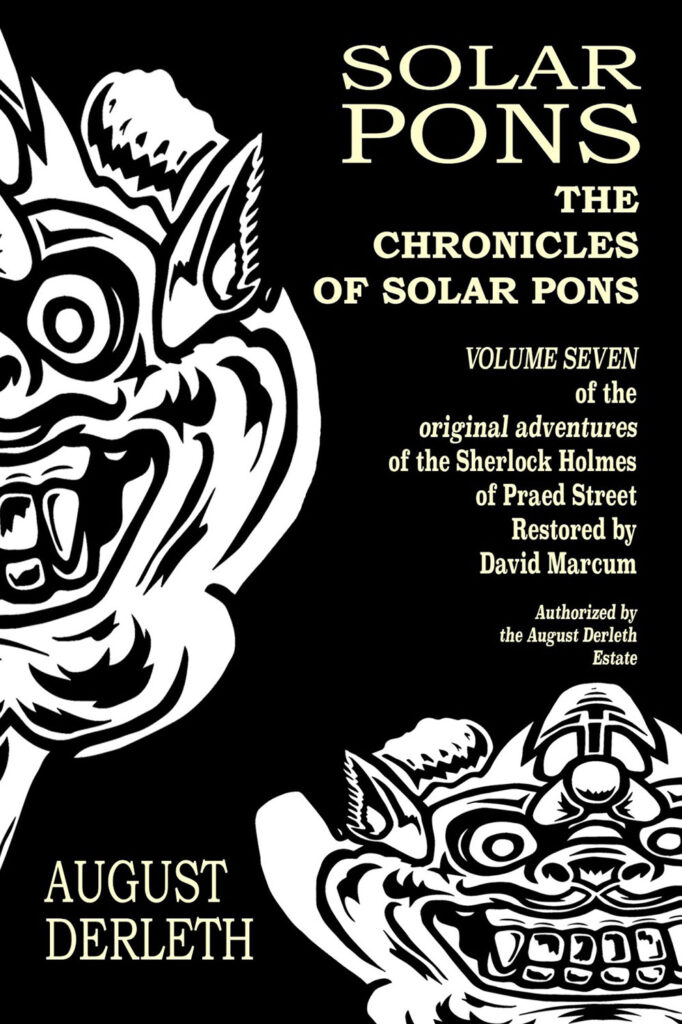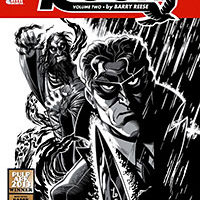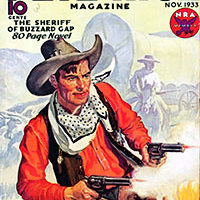 It was also published posthumously, as Derleth had passed away in 1971. As I understand it, he had finalized this work, even soliciting the introduction, before he passed. Pinnacle would soon put out the Solar Pons collections in 1974, and this one was reprinted as vol. 2 in their series that year.
It was also published posthumously, as Derleth had passed away in 1971. As I understand it, he had finalized this work, even soliciting the introduction, before he passed. Pinnacle would soon put out the Solar Pons collections in 1974, and this one was reprinted as vol. 2 in their series that year.
Of these stories, only a few had seen print before hand, one having appeared in the pulps back in the 1930s! Why it took so long to get included in a collection, I have no idea. As there were still a few uncollected, was his plan to include them in a future volume that clearly never happened? No way of knowing.
As with all the Belanger Books volumes, we get two intros by David Marcum and Derrick Belanger.
Next we get the introduction by Allen J. Hubin from the original M&M volume. This one is a little more personal, as he had met Derleth briefly at his home, and had been asked to write the introduction, but didn’t finish it until after Derleth passed. So that colored his piece.
A strange, red leech is at the center of “The Adventure of the Red Leech,” of course. A young, unmarried lady comes to Pons concerned when she received a package with a red leech in it. Her brother had received one, had a stroke, and was unable to speak, but tried to convey something to her before dying a few days later. Now, she is concerned the same will happen to her. Her brother had been in the import/export business in Hanoi, before retiring to England and working in his rose garden. So what does this red leech mean? Does it relate to his past business? And what was he trying to convey? Can Pons work it out before something happens to his client?
As the title implies, “The Adventure of the Orient Express” is a story set on this well-known train. But it’s not your usual story. It’s twice the length of any other. Pons doesn’t appear until the end, so the story is centered on Dr Lyndon Parker. He has been in Prague for a conference and is told to take the train on his return, to share a compartment with a Baron Von Ruber, and to follow his instructions. Apparently, the Baron is a double agent for Britain, as Germany has been taken over by the Nazi and is agitating for war. This is more a story of espionage than mystery, but we’ve had a few of these. Can Parker get to England safely? Will the saintly adventurer he encounters help him? And what about the little Belgium detective? Is he a friend or foe?
We have a different tale in “The Adventure of the Golden Bracelet.” An archaeologist comes to Pons with a strange request. He has come under attack due to a paper he published that contained drawings and etchings of pieces from Turkey. Turkey claims these are a valuable treasure that has gone missing and that the archaeologist had to have stolen them. His reputation and career are on the line. He gives a strange story of how he was able to see the items and make his drawings. He wants Pons to find the treasure. Can he do so and discover what is really going on?
Pons always avoided divorce cases, but for some reason doesn’t in “The Adventure of the Shaplow Millions.” The divorced wife of a major in the “Second Regiment in the King’s Horse Guard” has come to Pons for help. Her big issue is being cut out of a “big case” that her husband had brought against a bank worth 7 million pounds! Pons takes the case, but why? Clearly he sees something that others didn’t.
We have another case of apparent revenge in “The Adventure of the Benin Bronze.” A young woman comes to Pons with an issue hanging over her uncle. He had been in the military many years past, though he doesn’t speak of it, having experienced something horrible. Now, something from his past seems to be menacing him. He has been receiving strange messages, there are sounds of a frog not native to England that was also a signal of a Benin secret society, and a strange black man has been seen in their neigborhood. Can Pons act before tragedy strikes?
Pons’ brother Bancroft brings him the case of “The Adventure of the Missing Tenants.” The Italian consul has disappeared from a house he rents for private meetings. Is this a matter of political intrigue? But we also learn that his house has a sinister history. The builder was a surgeon with interests in psychology, who retired to it after having a nervous breakdown, then he disappeared. Since then, several other tenants have disappeared without explanation. Is all of this connected? Can Pons find the consul before it’s too late?
Several cases come together in “The Adventure of the Aluminum Crutch.” Inspector Jameson drops by to chat with Pons, mentioning several cases they are having problems solving. One deals with art thefts; another is an artist who was killed, his crutch broken. Then Mrs. Hudson‘s friend asks for help. A widow, she knows someone has come into her home. Nothing was taken, but she noticed a few items had been moved. And speaking with some neighbors, Jameson finds this happened to a few others. Pons takes the case. Will he be able to figure what is going on and hand it over the Jameson?
In “The Adventure of the Seven Sisters,” we have the one case that Jameson feels is Pon’s “greatest failure.” Is it? This is a strange one. Pons is approached by a man wanting him to look into the recent mysterious death of his brother, who was found strangled in a subway car. He found two strange notes, which are signed with seven stars in the form of the constellation called the Seven Sisters, that demanded money in the name of a different woman. Pons discovers that two other men, who seem to have connections to the man, were killed the same way. And it all seems to lead to a certain doctor in Limehouse. What is going on?
A woman who had helped Pons in a case 10 years prior ask him to look into “The Adventure of the Bishop’s Companion.” The bishop in this case sent her a bill for a baptism, which she felt was unnecessary. The bishop had retired, and his companion had recently died, so doesn’t know if this is the cause of it. And we learn that the tompstone of his companion was damaged. It seems a minor case, but Pons sees more in it. Is there more to it all?
Finally, we get a Pons Christmas tale in “The Adventure of the Unique Dickensians.” And as it’s Christmas, Pons and Parker are visited by a potential client who seems straight out of a Dickens story. He wants to engage Pons to deal with someone who is bothering him by loudly selling walnuts in front of his house. Pons and Parker visit and find that he’s a collector of Dickens works. Will Pons be able to help his client, and in what manner?
There are several interesting stories here. We have a wider variety of tales than in the past. I enjoyed the “Red Leech.” The “Orient Express” is a different and longer work, and for that, it is enjoyable. I think most will grasp who the “guest stars” are, so to speak. I very much liked the “Golden Bracelet,” “The Shaplow Millions,” and “The Aluminum Crutch.” It was neat to get a return of that certain doctor in “Seven Sisters,” but we get no mention of their other meetings. “The Missing Tenants” almost gets into weird-menace territory. The “Unique Dickensians” is a rare Christmas tale, and in a class by itself.
Next up is the true final collection of August Derleth’s Pons works, The Apocrypha of Solar Pons.



